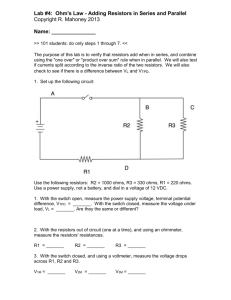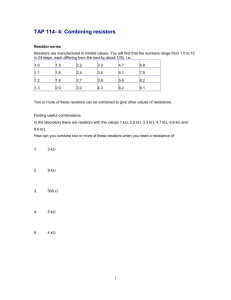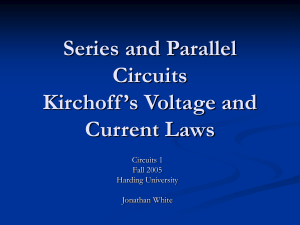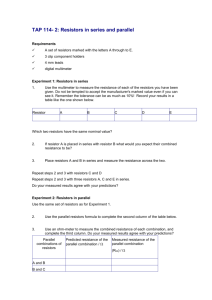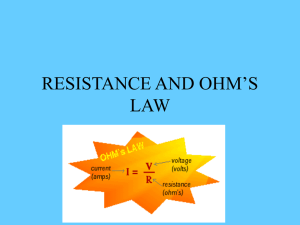Ohm`s Law - La Salle University
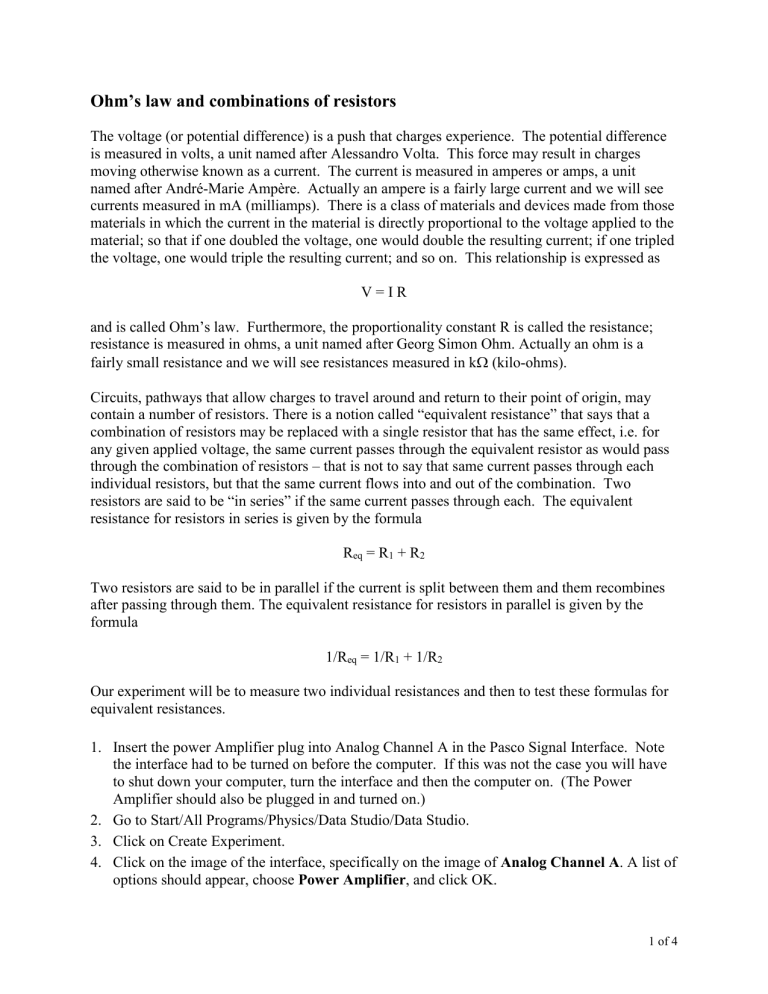
Ohm’s law and combinations of resistors
The voltage (or potential difference) is a push that charges experience. The potential difference is measured in volts, a unit named after Alessandro Volta. This force may result in charges moving otherwise known as a current. The current is measured in amperes or amps, a unit named after André-Marie Ampère. Actually an ampere is a fairly large current and we will see currents measured in mA (milliamps). There is a class of materials and devices made from those materials in which the current in the material is directly proportional to the voltage applied to the material; so that if one doubled the voltage, one would double the resulting current; if one tripled the voltage, one would triple the resulting current; and so on. This relationship is expressed as
V = I R and is called Ohm’s law. Furthermore, the proportionality constant R is called the resistance; resistance is measured in ohms, a unit named after Georg Simon Ohm. Actually an ohm is a fairly small resistance and we will see resistances measured in k
(kilo-ohms).
Circuits, pathways that allow charges to travel around and return to their point of origin, may contain a number of resistors. There is a notion called “equivalent resistance” that says that a combination of resistors may be replaced with a single resistor that has the same effect, i.e. for any given applied voltage, the same current passes through the equivalent resistor as would pass through the combination of resistors – that is not to say that same current passes through each individual resistors, but that the same current flows into and out of the combination. Two resistors are said to be “in series” if the same current passes through each. The equivalent resistance for resistors in series is given by the formula
R eq
= R
1
+ R
2
Two resistors are said to be in parallel if the current is split between them and them recombines after passing through them. The equivalent resistance for resistors in parallel is given by the formula
1/R eq
= 1/R
1
+ 1/R
2
Our experiment will be to measure two individual resistances and then to test these formulas for equivalent resistances.
1.
Insert the power Amplifier plug into Analog Channel A in the Pasco Signal Interface. Note the interface had to be turned on before the computer. If this was not the case you will have to shut down your computer, turn the interface and then the computer on. (The Power
Amplifier should also be plugged in and turned on.)
2.
Go to Start/All Programs/Physics/Data Studio/Data Studio.
3.
Click on Create Experiment.
4.
Click on the image of the interface, specifically on the image of Analog Channel A . A list of options should appear, choose Power Amplifier , and click OK.
1 of 4
5.
A Signal Generator window should appear. Use the drop-down list to choose DC Voltage and enter 1 in the textbox under DC Voltage.
6.
Connect a wire from the positive (red) signal output of the power amplifier to Resistor A.
7.
Convert your multimeter to an ammeter. Insert the red lead in the mA slot and press the mA button.
2 of 4
8.
Insert the red needle of the multimeter into the hole adjacent to Resistor A. Insert the black needle into the negative (black) terminal of the power amplifier.
9.
Click the Start button on the menu. After the current reading has settled down, record the reading in the table below. (If you get no current check that the circuit is set up properly and that the connections are good.)
10.
Increase the voltage by 1 V and repeat the measurements until you reach 5 V.
Resistor A
Voltage (supply the Current (supply units here)
1.0 the units here)
2.0
3.0
4.0
5.0
Repeat the measurements for Resistor B.
Resistor B
Voltage (supply the Current (supply units here)
1.0 the units here)
2.0
3.0
4.0
5.0
Place Resistors A and B “in series” and repeat the measurements. (Resistors A and B are said to be in series if the current must pass through both A and B.) Note that the ammeter is also “in series.”
Resistors A and B in series
Voltage (supply the units here)
Current (supply the units here)
1.0
2.0
3.0
4.0
5.0
3 of 4
Place Resistors A and B “in parallel” and repeat the measurements. (Resistors A and B are said to in parallel if the current can pass through either A or B.)
Resistors A and B in parallel
Voltage (supply the units here)
1.0
Current (supply the units here)
2.0
3.0
4.0
5.0
Plot Current versus Voltage for each of the four sets of measurements. Fit the data to a straight line and extract the resistance. You can find the instructions for making such plots in Excel on my CSC 152 page ( http://alpha.lasalle.edu/~blum/c152wks/c152xyplot1.htm
). Be careful, the example there plots Voltage versus Current . Compare the resistance for the series and parallel combinations to the theoretical values (i.e. use a formula). Paste the charts near the table with the corresponding data.
Combination
A
Resistance from graph (unit)
Theoretical resistance (unit)
XXX
XXX B
A and B in series
A and B in parallel
4 of 4

